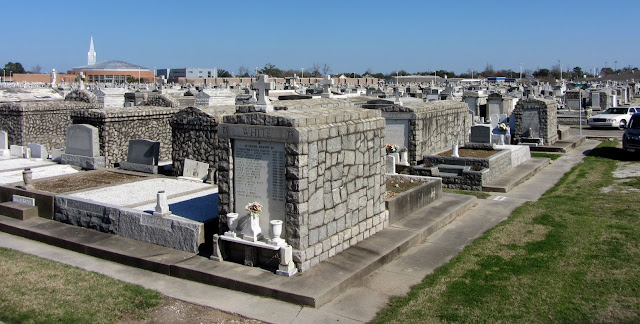Big and Easy 'Boxing
A letterboxer who moved to the Crescent City from Florida planted the vast majority of the letterboxes. Old New Orleans cemeteries were among his favorite locations for hiding these urban treasures. Although we have visited some of these hallowed grounds before, we became much better acquainted with them on this visit.
Owned by the city of New Orleans, Carrollton Cemetery dates back to 1849. The graveyard was originally divided into sections for "colored" and "white." With the differing financial means available to each group, a distinct contrast can still be seen between the two, with mostly in-ground burials in the "colored" section and more elaborate tombs and markers in the "white" section.
Lest it appear disrespectful to search for letterboxes in these hallowed grounds, let us point out that the clues for these boxes gave very specific locations, down to pinpointing the x and y axis in photo clues. When you looked at the picture in imaging software and identified the coordinates provided in this clue, you knew immediately to look in the bottom of the two stacked concrete blocks. There's no willy-nilly turning things over, so nothing important is disturbed in the search. We had not seen this particular strategy before but really appreciated the idea.
 |
| Holt Cemetery |
Unlike other New Orleans cemeteries where most deceased are interred in above-ground tombs due to the city's shallow water table, Holt's graves are all underground burials. And as is common in the city, multiple burials are allowed on the same plot. Almost all markers and plot edgings are home made and bear tender sentiments of those who loved these people. We were particularly saddened by the relatively young age of some of the deceased and wondered how their young lives had ended so abruptly.
 |
| Greenwood Cemetery |
 |
| Treasure at Loyola University Law Library |
By the end of two very full days in New Orleans, our letterbox find count had increased by 87. Since our "normal" average when traveling is four or five boxes per day, this was a remarkable number. Not surprisingly, this did not represent 87 different containers at that many locations, a feat which would require nonstop searching and stamping with no time for food or rest. Our friendly local letterboxer seems to enjoy carving stamps much more than he likes seeking out clever hiding places for them. His solution is to just add a new "box" (stamp and logbook) to the container where one of his other boxes already resides. So it was quite common to find two, three or more "boxes" in one container.
We searched cemeteries, libraries, parks, church grounds, street corners, and businesses. But by far the most unusual place we found some of these New Orleans treasures was on the grounds of private homes. In the clues, the homeowners were described as "letterbox friendly" but wishing to enjoy their privacy while hosting these special repositories in their yards. Our final stopping place of the second day was yet another home which we suspect to be the residence of the planter. Rather than searching for a hidden cache, we found a stack of tupperware containers sitting in the open on the side porch. Not much of a challenge, but the stamps were a nice reward, and the treasure in the chest can be increased any time of the day or night, whenever he finishes carving his latest masterpiece.
TRIP STATS
- Days: 25
- Miles driven: 4,670
- States visited: 8
- Letterboxes found: 186


























































